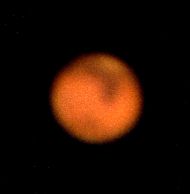
Mars is named for the Roman god of war. It is a harsh, rugged, dry planet. However, the surface of Mars reveals features that suggest that Mars once had large amounts of flowing water long ago in its history. Recent studies suggest that the gullies and other erosion features may be formed by another process that does not involve water erosion. Today Mars has water vapor in its atmosphere, and solid frozen water in its north pole ice cap. In the Martian winter, the northern polar ice cap includes layers of frozen carbon dioxide. The ice cap at the south pole is frozen carbon dioxide. Mars has a thin atmosphere made up of 95 percent carbon dioxide, with 2 to 3 percent nitrogen, 1 to 2 percent argon, and 0.1 to 0.4 percent oxygen, with traces of water vapor and other gases. Mars occasionally has fog and clouds, and I have observed such clouds with my 5 inch refractor telescope.
Mars orbits the Sun in about 687 days. A Martian day lasts 24 hours and 37 minutes. Mars is smaller than the Earth. The planet's diameter is 4,220 miles at the equator, as compared to the Earth's 7,930 mile diameter. In addition, Mars has only 0.11 the mass of the Earth. Consequently, the surface gravity is only about a third of the Earth's gravity. A person who weighed 100 pounds on the Earth would only weigh 38 pounds on Mars.
Mars has the largest volcano in the solar system. Olympus Mons towers almost 17 miles above the mean surface of the planet. Mars also has deep canyons. The largest canyon Valles Marineris is a complex network of rocky valleys extending 3000 miles around the equator with an average depth of 4 miles. The surface of Mars is covered with impact craters.
The South Pole of Mars is near the top in this photo. The dark area near the South Pole is Mare Tyrrhenum and Iapygia. The dark finger-like area protruding from the top is Syrtis Major. The dark area near the bottom edge is Utopia, and is near the Martian North Pole.
This photo was taken with a Takahashi FS-128 refractor using eyepiece projection (5mm occular). The film was Kodak Elitechrome 100 slide film.
Constellation: Virgo
RA: 14h 14m 14.7s Dec: -11d 55' 23"
April 21, 1999
Photo by Sid Leach
Iola, Texas
Recent Images.
Complete list of images.
Description of equipment used to acquire images.
Home
Feedback and comments should go to Sid